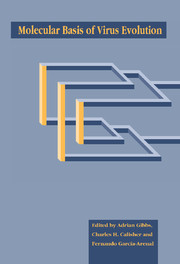Book contents
- Frontmatter
- Contents
- List of contributors
- Editors' preface
- Conference participants
- 1 Introduction and guide
- Part I The impact of viral diseases
- Part II Origins of viruses and their genes
- 4 Origin of RNA viral genomes; approaching the problem by comparative sequence analysis
- 5 Origins of DNA viruses
- 6 In search of the origins of viral genes
- 7 Cellular sequences in viral genomes
- Part III Sources of virus variation
- Part IV Molecular interactions of viruses and their hosts
- Part V Viruses, hosts and populations
- Part VI Case studies of viral taxa; their systematics and evolution
- Part VII Techniques for viral systematics
- Index
7 - Cellular sequences in viral genomes
Published online by Cambridge University Press: 04 May 2010
- Frontmatter
- Contents
- List of contributors
- Editors' preface
- Conference participants
- 1 Introduction and guide
- Part I The impact of viral diseases
- Part II Origins of viruses and their genes
- 4 Origin of RNA viral genomes; approaching the problem by comparative sequence analysis
- 5 Origins of DNA viruses
- 6 In search of the origins of viral genes
- 7 Cellular sequences in viral genomes
- Part III Sources of virus variation
- Part IV Molecular interactions of viruses and their hosts
- Part V Viruses, hosts and populations
- Part VI Case studies of viral taxa; their systematics and evolution
- Part VII Techniques for viral systematics
- Index
Summary
Introduction
Recombination of viral and host cellular nucleic acids probably plays a major role in the evolution of viruses. By this means, a virus is able to exploit a large gene pool and to acquire new properties very rapidly. The presence of cellular genes or gene fragments within the genomes of retroviruses (v-oncogenes) is well established. For other viruses, the cellular origin of certain genes has been suggested. Direct evidence is, however, difficult to obtain, probably because elaborate mutational changes of the cellular sequences occurred in the viral genomes. For some non-retro viruses, however, sequences homologous to cellular genes have been identified. We will discuss examples of these very recent recombination events with emphasis on bovine viral diarrhoea virus (BVDV).
Cellular sequences in the genome of BVDV
Identification of host cell-derived insertions
BVDV is a member of the genus pestivirus within the family Flaviviridae (Wengler, 1991). The pestiviral genome consists of single-stranded RNA with positive polarity of about 12 kilobases (kb) (Collett et aL, 1988; Meyers, Riimenapf & Thiel, 1989∧). The first third of this RNA codes for an autoprotease and four structural proteins, while the 3’ part of the genome encodes the other non-structural proteins (Collett et ai, 1991; Thiel et al., 1991). The genome of BVDV, like that of all flaviviruses, is translated into a single polyprotein which is co- and post-translationally cleaved to give rise to mature viral proteins.
- Type
- Chapter
- Information
- Molecular Basis of Virus Evolution , pp. 91 - 102Publisher: Cambridge University PressPrint publication year: 1995
- 1
- Cited by



